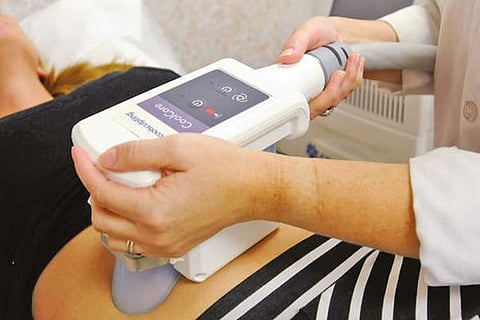

Chennai
After treatment, Evangelista said, she developed a condition known as paradoxical adipose hyperplasia, or PAH, in which the tissue in the treated area grows larger and hardens and stays that way. PAH is sometimes referred to as the “stick of butter effect,” because it can look like a stick of butter hidden under the skin; the enlarged tissue matches the long, thin shape of the CoolSculpting applicator.
“PAH has not only destroyed my livelihood, it has sent me into a cycle of deep depression, profound sadness, and the lowest depths of self-loathing,” Evangelista wrote. She filed a lawsuit on Tuesday against Zeltiq Aesthetics Inc., the subsidiary of Allergan that markets and licenses CoolSculpting devices, claiming that the company had “intentionally concealed” the risks and had “failed to adequately warn” consumers, including Evangelista, about them.
CoolSculpting is an outpatient treatment, approved by the Food and Drug Administration, that is designed to kill fat cells near the surface of the skin by cooling them in a process known as cryolipolysis. Scientists first proposed the idea behind the technique in 2008, based on the existence of a rare phenomenon that afflicts kids, called Popsicle panniculitis.
When some young children suck on Popsicles, their cheeks develop permanent divots because the cold damages nearby fat cells. Similarly, doctors had noticed in 1980 that when women go horseback riding in the cold, they sometimes lose fat around their thighs. CoolSculpting isn’t intended to help people lose significant amounts of weight, though. “This is not a weight-loss treatment,” said Dr. Paul M. Friedman, a dermatologist in Houston and the director of the Dermatology & Laser Surgery Centre there. It “is meant for stubborn pockets of fat that are non-responsive to diet and exercise in patients who are at their ideal body weight,” he said. Licensed by Zeltiq Aesthetics, CoolSculpting can be administered by doctors — usually dermatologists or plastic surgeons. After applying gel to the skin to protect it from damage, the doctor will use special applicators to cool the skin to just above the freezing point in fatty areas such as the chin, the abdomen, the thighs, the arms, the back or underneath the buttocks. The cold, which is administered to the skin for 30 minutes to two hours, “kills off fat cells, without damaging surrounding nerves, muscles, or skin cells,” said Dr. Whitney Bowe, a New York City-based dermatologist.
Over the next one to six months, the fat cells die, Dr. Bowe said, and patients usually see a reduction in fat in the treated areas of about 20 percent; patients will often have two or more treatments to the same area to reduce fat by 40 to 50 percent, eliminating small bulges and giving the area a more toned look. Treatment regimens usually range in price from $600 to $3,000, Dr. Bowe said. More than eight million CoolSculpting treatments had been administered in the U.S. as of 2019, according to the CoolSculpting website. The American Society for Aesthetic Plastic Surgery reports that board-certified U.S. plastic surgeons performed 129,686 non-surgical fat-reducing treatments in 2019, a category that includes CoolSculpting as well as treatments that use ultrasound to kill fat cells.
Moyer is a journalist with NYT©2021
The New York Times
Visit news.dtnext.in to explore our interactive epaper!
Download the DT Next app for more exciting features!
Click here for iOS
Click here for Android